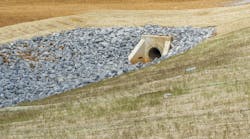Investigating BMPs’ Impact on Roadway Infrastructure
It is well known that storm water runoff from developed areas can degrade the quality of downstream receiving waters in terms of sediment delivery, chemical constituents and elevated water temperature. Storm water runoff volume and peak flow are also larger from developed areas. This can adversely affect receiving waters and the stability of the channels of streams receiving the storm water runoff.
To protect receiving waters from these negative effects, a variety of storm water best management practices (BMPs) have been developed for use in both developed and developing areas. In many instances, storm water BMPs are located adjacent to roadways, and some concern has been expressed that these BMPs might have adverse effects on the roadway function and long-term cost.
The study presented in this article had a goal of evaluating storm water BMPs that are located adjacent to roadway infrastructures. The primary objective was to assess the potential adverse impact of storm water BMPs on the function and long-term operational cost of roadways. A secondary objective was to assess whether various BMPs are functioning according to design standards. The storm water BMPs assessed included dry ponds, wet ponds, constructed wetlands, infiltration basins, infiltration trenches, sand filters, grassed swales and bioretention areas.
Researchers studied roadside storm water BMPs.
The Acceptability Consensus
One task of the study was to assess the degree of acceptability of storm water BMPs among professionals most commonly associated with roadway planning, design and maintenance. This assessment was performed through a Web-based opinion survey concentrated within the counties of Minnesota’s Twin Cities metro area. Overall, the conclusion of the survey indicated a high degree of acceptability and satisfaction with the functioning of storm water BMPs. There was no strong indication that benefits of storm water BMPs are outweighed by the costs.
Evaluation of the potential negative impact of storm water BMPs on roadway function and cost was based on the fact that extra moisture introduced into pavement subgrade material from an adjacent BMP will reduce the strength of the pavement foundation. The pavement life cycle, then, could decrease.
Schematic of a roadway cross-section
Studying Pavement Distress
This potential impact on pavements was tested in two ways. The first was with observations of pavements in the field using the Minnesota Department of Transportation (Mn/DOT) distress index represented by the surface rating index. Field measurements of surface ratings for 45 pavement sections located adjacent to BMPs were compared to those of control sections located far from BMPs. Statistical analysis of this data indicated that the BMPs had no measurable adverse effect on the investigated pavements.
The limitation of this analysis was that many of the investigated pavements were recently overlaid, and it is possible, therefore, that visible stress might not have had time to manifest. Field observations should continue to be taken in the future to determine whether pavement distress can be related to the presence of BMPs.
The second way to evaluate the potential negative impact of BMPs on roadways was to use the Mn/DOT pavement design and performance model, MnPAVE. This model allows the direct calculation of pavement longevity as related to subgrade properties. Subgrade moisture content influences pavement foundation strength, so it was possible with MnPAVE to model the relation between a potential increase in moisture content and pavement life cycle conditions.
With this part of the project, it was shown that increases in moisture content, whether from BMPs or other sources of moisture, can significantly reduce a pavement’s life cycle. This reduction leads to an increase in long-term costs for construction and maintenance. Additional work is needed to acquire observations of subgrade moisture contents to determine if BMPs actually increase subgrade moisture contents in comparison to control sections.

